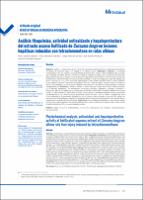| dc.contributor.author | Canelo-Saldaña, Piero | |
| dc.contributor.author | Mendoza-Gardini, Yrani | |
| dc.contributor.author | Villacres Vallejo, Jorge | |
| dc.contributor.author | Aranda-Ventura, Jose | |
| dc.contributor.author | Gonzalez-Aspajo, German | |
| dc.date.accessioned | 2023-06-20T21:13:18Z | |
| dc.date.available | 2023-06-20T21:13:18Z | |
| dc.date.issued | 2017-12-19 | |
| dc.identifier.citation | Revista Peruana de Medicina Integrativa. 2017; 2(3). | es_PE |
| dc.identifier.uri | https://hdl.handle.net/20.500.12959/3962 | |
| dc.description.abstract | Objetivos. Realizar un análisis fitoquímico y describir la actividad hepatoprotectora y antioxidante del extracto de rizomas de Curcuma longa L. (C. longa) en un modelo murino. Materiales y métodos. La actividad antioxidante in vitro del extracto acuoso liofilizado de rizoma de C. longa L. (Fam: Zingiberaceae) se evaluó con el método de DPPH, además, también se realizó el análisis fitoquímico de tres solventes de extracción (ExEt, ExDCM y ExH2O). El ensayo in vivo se realizó en ratas albinas cepa Holtzman. Se formaron cinco grupos de tratamiento: (control normal); (control-CCl4); (Control positivo); (C. longa 100 mg/kg) y (C. longa 200 mg/kg), que fueron inducidos con CCl4 para desarrollar daño hepático. Este modelo permitió medir el efecto protector de los extractos sobre los marcadores bioquímicos (AST, ALT y ALP) en sangre. Posteriormente, se realizó un examen histopatológico de las secciones hepáticas para apoyar la inducción de la hepatoxicidad y la eficacia hepatoprotectora. Resultados. El extracto mostró un poder reductor mucho menor que el ácido ascórbico, en el tamizaje fitoquímico se encontraron compuestos fenólicos, triterpenos, quinonas, cumarinas y flavonoides, además la cantidad de curcumina encontrada fue de 0,4%-0,6%. El extracto liofilizado de C.longa mostró un efecto protector significativo (P<0,05), disminuyendo la actividad enzimática de los marcadores hepatoespecíficos. Los niveles elevados de enzimas séricas AST, ALT y ALP, se hallaron restablecidas hacia la normalización, de manera dosis dependiente, con el máximo efecto protector a dosis de 200 mg/kg. Las observaciones histopatológicas soportan las evidencias bioquímicas de hepatoprotección. Estos efectos fueron comparables a la droga estándar, silimarina. Conclusiones. Los resultados presentados en este estudio revelan fuertemente el efecto protector del extracto liofilizado de C. longa, cultivada en la región Loreto, frente a daño hepático inducido por CCl4 en experimentación animal. | es_PE |
| dc.description.abstract | Objectives. To develop a phytochemical analysis and describe the hepatoprotective and antioxidant activities of
Curcuma longa (C. longa) rhizomes extract in a murine model. Materials and methods. In vitro antioxidant activity
of aqueous liofilizated extract of rhizome of C. longa L. (Fam: Zingiberaceae) was evaluated by DPPH assays, and
the phytochemical analysis of three extraction solvents (ExEt, ExDCM and ExH2O) was also performed. The in vivo
assay was made in holtzman albino rats. Five treatment groups were formed: (Normal control); (CCl4- control);
(Positive control); (C. longa 100 mg / kg) and (C. longa 200 mg / kg), which were induced with CCl4 to develop liver
damage. This model allowed measuring the protective effect of the extracts on blood biochemical markers (AST,
ALT and ALP). Further histopatological examination of the liver sections was carried out to support the induction
of hepatoxicity and hepatoprotective efficacy.Results. The extract showed a reduction power much lower than
ascorbic acid. In the phytochemical screening, phenolic compounds, tripterpenes, quinones, coumarins and
flavonoids were found. In addition, the amount of curcumin found was 0.4% - 0.6%. The lyophilized extract of C.
longa showed a significant protective effect (P <0.05), decreasing the enzymatic activity of the hepato-specific
markers. Elevated levels of AST, ALT and ALP serum enzymes were restored to normalization in a dose-dependent
manner with the maximum protective effect at doses of 200 mg / kg. Histopathological observations support
the biochemical evidence of hepato-protection. These effects were comparable to the standard drug, silymarin.
Conclusions. The results presented in this study strongly reveal the protective effect of C longa lyophilized extract
grown in the Loreto region against CCl4 induced liver damage in animal experiments. | es_PE |
| dc.format | application/pdf | es_PE |
| dc.language.iso | spa | es_PE |
| dc.publisher | Seguro Social de Salud (EsSalud) | es_PE |
| dc.relation.uri | https://rpmi.pe/index.php/rpmi/article/view/667 | es_PE |
| dc.rights | info:eu-repo/semantics/openAccess | es_PE |
| dc.rights.uri | https://creativecommons.org/licenses/by-nc-sa/4.0/ | es_PE |
| dc.subject | Curcuma | es_PE |
| dc.subject | Antioxidantes | es_PE |
| dc.subject | Curcumina | es_PE |
| dc.subject | Tetracloruro de carbono | es_PE |
| dc.subject | Hepatoprotector | es_PE |
| dc.subject | Antioxidants | es_PE |
| dc.subject | Curcumin | es_PE |
| dc.subject | Carbon tetrachloride | es_PE |
| dc.subject | Hepatoprotector | es_PE |
| dc.title | Análisis fitoquímico, actividad antioxidante y hepatoprotectora del extracto acuoso liofilizado de Curcuma longa en lesiones hepáticas inducidas con tetraclorometano en ratas albinas | es_PE |
| dc.title.alternative | Phytochemical analysis, antioxidant and hepatoprotective activity of liofilizated aqueous extract of Curcuma longa on albino rats liver injury induced by tetrachloromethane | es_PE |
| dc.type | info:eu-repo/semantics/article | es_PE |
| dc.subject.ocde | https://purl.org/pe-repo/ocde/ford#3.02.29 | es_PE |
| dc.identifier.doi | https://doi.org/10.26722/rpmi.2017.23.60 | |






